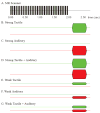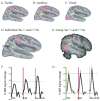Touch, sound and vision in human superior temporal sulcus
- PMID: 18440831
- PMCID: PMC2409200
- DOI: 10.1016/j.neuroimage.2008.03.015
Touch, sound and vision in human superior temporal sulcus
Abstract
Human superior temporal sulcus (STS) is thought to be a key brain area for multisensory integration. Many neuroimaging studies have reported integration of auditory and visual information in STS but less is known about the role of STS in integrating other sensory modalities. In macaque STS, the superior temporal polysensory area (STP) responds to somatosensory, auditory and visual stimulation. To determine if human STS contains a similar area, we measured brain responses to somatosensory, auditory and visual stimuli using blood-oxygen level dependent functional magnetic resonance imaging (BOLD fMRI). An area in human posterior STS, STSms (multisensory), responded to stimulation in all three modalities. STSms responded during both active and passive presentation of unisensory somatosensory stimuli and showed larger responses for more intense vs. less intense tactile stimuli, hand vs. foot, and contralateral vs. ipsilateral tactile stimulation. STSms showed responses of similar magnitude for unisensory tactile and auditory stimulation, with an enhanced response to simultaneous auditory-tactile stimulation. We conclude that STSms is important for integrating information from the somatosensory as well as the auditory and visual modalities, and could be the human homolog of macaque STP.
Figures





References
-
- Adolphs R. Cognitive neuroscience of human social behaviour. Nat Rev Neurosci. 2003;4:165–178. - PubMed
-
- Allison T, Puce A, McCarthy G. Social perception from visual cues: role of the STS region. Trends Cogn Sci. 2000;4:267–278. - PubMed
-
- Allman BL, Meredith MA. Multisensory processing in “unimodal” neurons: cross-modal subthreshold auditory effects in cat extrastriate visual cortex. Journal of Neurophysiology. 2007;98:545–549. - PubMed
-
-
Aristotle, 350 B.C.E. On Sense and the Sensible. The Internet Classics Archive, translated by J. I. Beare.
-
Publication types
MeSH terms
Grants and funding
LinkOut - more resources
Full Text Sources

